
Intro
Photos of some wild-looking direct-mount SRAM derailleurs have been floating around the internet for a while now, and today they’re announcing the new Eagle Transmission.
First things first: SRAM is not calling the new Eagle groupsets a “drivetrain.” The official terminology is that it’s a “transmission,” in a nod to the increased degree of integration that the whole package offers. The shorthand for the new transmission parts is “T-Type” to indicate compatibility with the new groupsets, which are currently offered in three tiers — XX SL, XX, and X0 — with AXS wireless shifters and derailleurs, only.
They’re still 12-speed, but most of the parts aren’t cross-compatible with the longstanding Eagle 12-speed groups that SRAM has been offering for a long time now, and it’s also worth emphasizing that the Eagle Transmission isn’t replacing anything in SRAM’s lineup for the time being. Current Eagle groups are going to continue to be offered and supported for the foreseeable future. But SRAM has said that the new T-Type groups are where their development efforts are to be focused going forward — hinting that more versions of the Transmission are probably coming at some point — and that they think there are real benefits to the increased integration that the T-Type groups bring to the table.
The heart of the new integration is the new “Full Mount” derailleurs, which take the place of a SRAM UDH on frames that use them (non-UDH frames aren’t compatible), and tie the derailleur, rear axle, and cassette together with a degree of precision that simply isn’t possible with a conventional derailleur hanger. And as part of that increased integration, SRAM is touting dramatically streamlined installation and setup with almost no need for further adjustment or tuning of the derailleur, increased durability, and improved shifting, especially under power.
So how have they accomplished all of that? There’s a lot going on here, so let’s get right into it:
[A quick note on specs: we list measured weights for parts we’ve been able to get our hands on at this point and stated ones elsewhere, with clear indications of which are which. And all Euro / GBP prices listed include VAT.]
Derailleurs
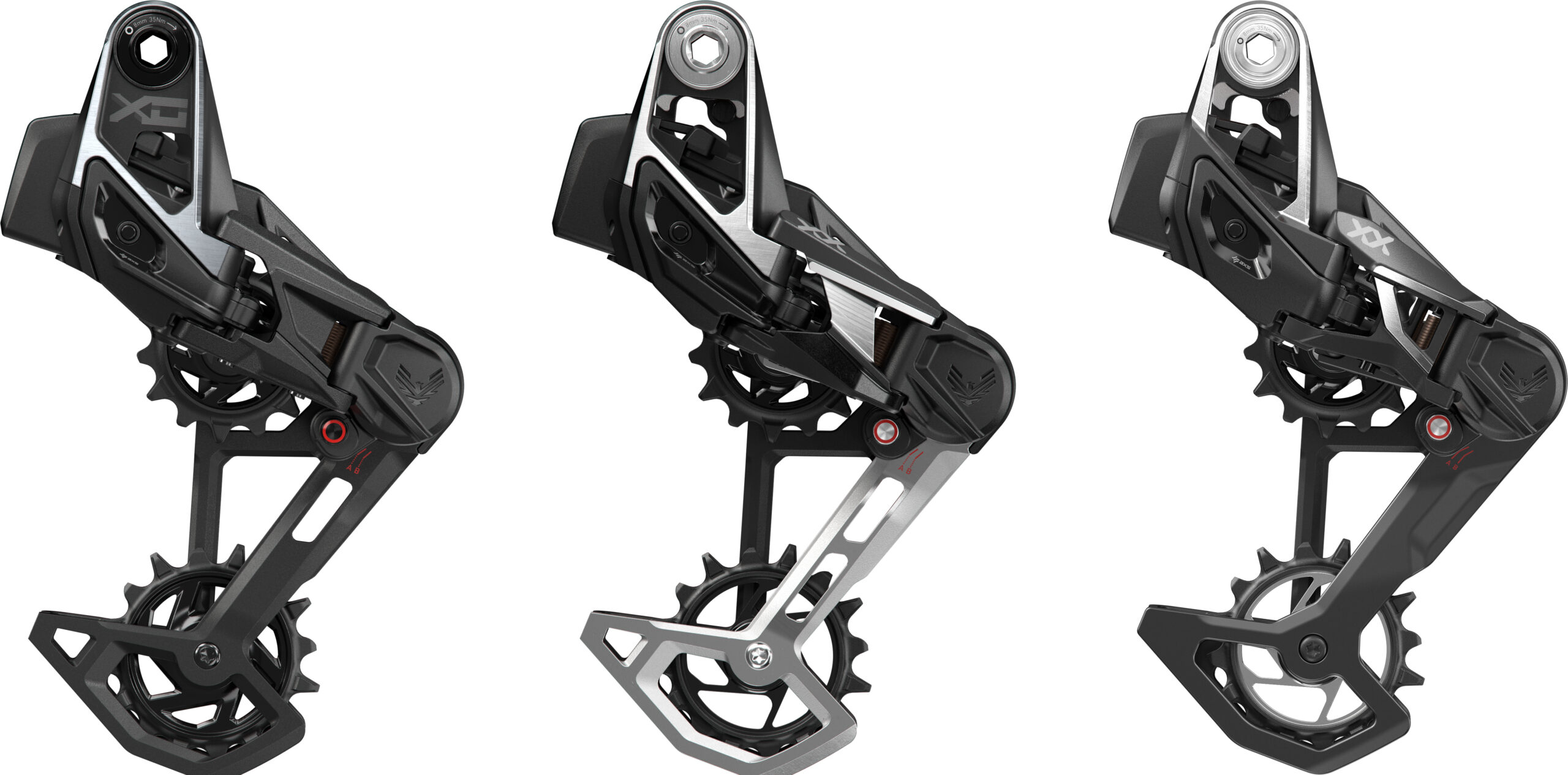
The new derailleurs are probably the first thing that caught most folks’ attention with the Eagle Transmission, and for good reason — they look pretty different from anything we’ve seen before. The big, headlining feature is the hangerless interface, which SRAM is calling a “Full Mount” design. In short, the new derailleurs attach directly to a UDH-compatible frame, and tie the frame, derailleur, and rear axle together, with the hub endcap mating up directly against the inside tab of the derailleur.
SRAM says this has a number of advantages. For one, it’s a much stronger, stiffer mount than a conventional derailleur hanger. Of course, the obvious counter to that is that derailleur hangers have historically tried to deliberately be the weak link in the system, and to fail in place of the far more expensive derailleur in the event of a severe impact. But SRAM says that the Full Mount is so much stronger than a regular derailleur and hanger that it’ll stave off damage all together in most instances.
And SRAM isn’t just relying on brute strength to protect the derailleur. As with their prior-generation AXS derailleurs, the new T-Type ones feature an overload clutch so that the derailleur will move inboard in the event of an impact, and the derailleur can pivot about the B-pivot (i.e., where it attaches to the frame at the rear axle) to mitigate an impact as well. In the event that the derailleur hits something and pivots backward, to prevent damage, the indexing plate that defines its rotation stays in place on the frame, so you can simply push the derailleur back forward until it hits its stop and get back on with your ride.
The new derailleurs also feature a variety of replaceable parts and “skid plates” to fend off damage. The upper and lower halves of the outer parallelogram link are replaceable in just a few minutes with standard tools, should you damage them, and the bushings on which they pivot are part of that replacement if you just plain wear them out. And while the prospect of disassembling your fancy, expensive derailleur might sound daunting, it’s genuinely straightforward — just undo a couple of bolts, then slide the parallelogram links apart, then reverse the process.
The concept of a direct-mount derailleur that forgoes a traditional hanger isn’t entirely new, but SRAM’s Full Mount implementation seems like a much more robust version of the concept than we’ve seen before and makes for a notably low-profile derailleur in terms of how far it protrudes from the frame, to help keep the derailleur from getting smashed on stuff in the first place.

Another advantage of the arrangement is that, since the hub end cap ties directly to the inner mounting face of the derailleur, the relative positioning of the derailleur and cassette are much more tightly controlled — and in fact, SRAM is so confident in that positioning that the new derailleurs don’t even feature limit screws. You can, of course, still use the micro-adjust feature either through the AXS app or on the controller if a little fine-tuning is required, but SRAM has made a big effort to minimize the amount of adjustment needed to get the new Eagle Transmission up and running. There’s also not a B-tension screw to adjust (though the B-tension does get set in a much more streamlined process, as we’ll describe in more detail below) — SRAM is talking a whole lot about simplicity and ease of use here.
There are some other interesting new features on the derailleurs, including what SRAM calls the “Inline Cage”. In short, the cage is bent (on purpose) to keep the lower tension pulley better aligned with the chainring. Basically, there’s a slight kink to the cage such that when the chain is in the higher gears (and the derailleur cage is therefore pointed back), the pulley angles inward slightly, toward the chain ring. As the cage pivots forward with shifts into lower gears, that same kink points the pulley outboard, again aiming it at the chainring. It’s probably easier to explain visually:

The whole process is very, very slick and SRAM says that replacement cages will be available for folks who need them. The cages from the different tiers of derailleur are also all cross-compatible to make finding a spare easier, or if you just want to mix and match for whatever reason.
The clutch mechanism has also been refined to give what SRAM says should be more consistent force over the life of the derailleur and slightly higher force overall; that does allegedly reduce battery life slightly, due to the increased loads during shifting, and we’ll report back with more on that in our full review.
SRAM’s longstanding Cage Lock feature (the button you can use to hold the derailleur cage in a forward position for ease of removing the rear wheel) also carries over, with the addition of a third intermediate position that gets used in the setup process — more on that below. If you’re not familiar, in short, there’s a button on the back side of the P-knuckle (where the cage attaches to the body of the derailleur) that pushes out a pin that you can use to hold the cage forward to de-tension the chain in order to make it easier to remove the wheel or perform other maintenance.
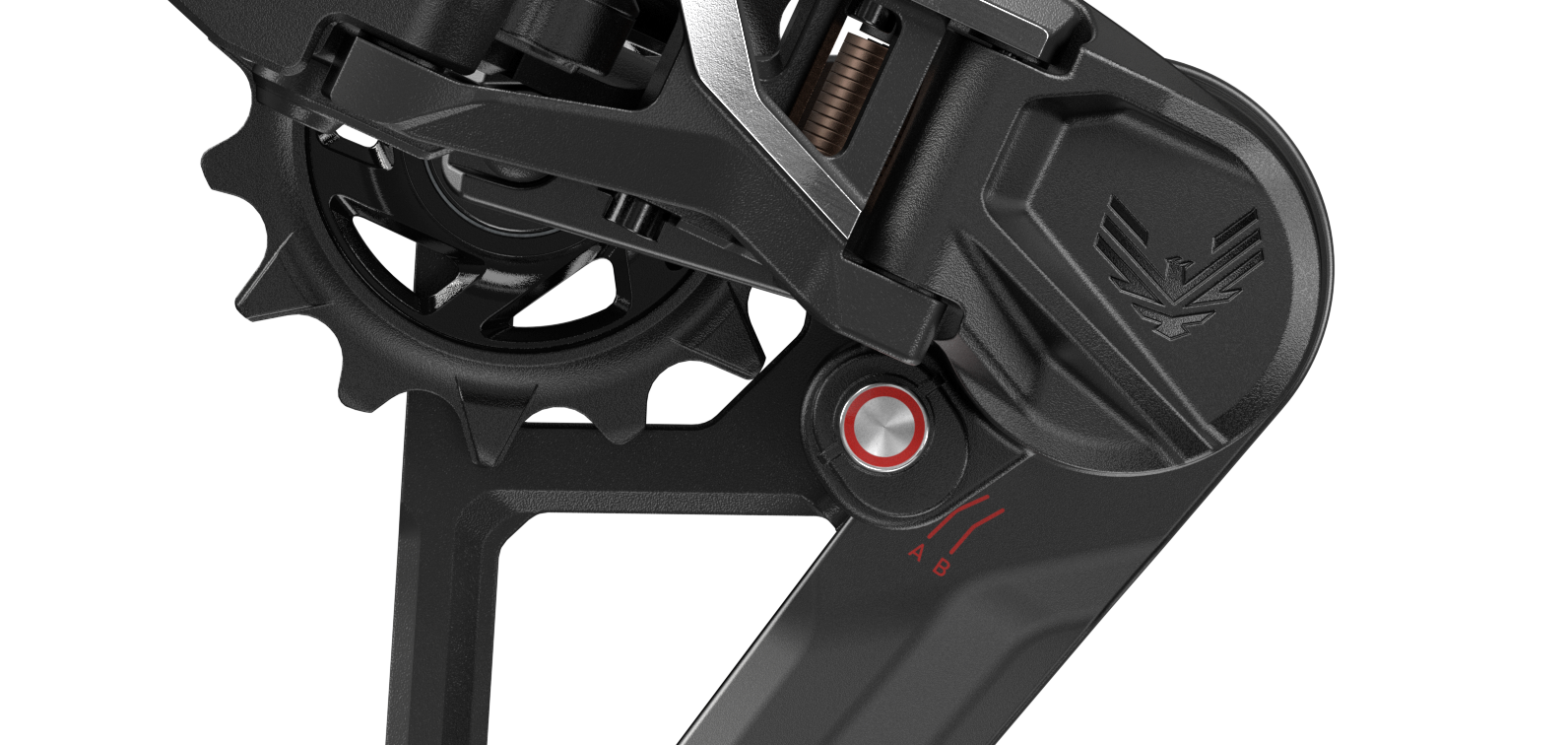
SRAM has also increased the derailleur pulley sizes, to 14 teeth on the upper guide pulley and 16 teeth on the lower tension one (from 12 upper / 14 lower on the original Eagle derailleurs). SRAM says the bigger pulleys reduce friction and wear as compared to the smaller older ones, and make for a slightly more compact derailleur cage due to the extra chain wrap that the bigger pulleys offer.
Derailleur Versions
As with the whole Transmission line, the derailleurs are broken into three tiers — X0, XX, and XX SL — and are only available in AXS electronic versions, at least for now. All three share the same overall design and most of the same features as described above, with a few key differences. If purchased a-la-carte, the derailleurs come without the battery or charger (which retail for $59 and $49, respectively) but they are included with the full groupsets, as detailed below.
XX SL Derailleur
- MSRP: $650 / €700 / £695 (Battery not included)
- Stated Weight: 440 g

At the top of the heap is the XX SL derailleur, meant for XC race use. The XX SL derailleur uses a carbon fiber cage and pares back the replaceable skid plates featured on the other models (more on those in a minute).
The tension pulley is what SRAM calls a “Magic Wheel” — in short, the outer ring of the pulley that contains the teeth can spin independently of the center spoked section so that it won’t jam if something gets lodged between the cage and the spokes on the pulley. That interface has more friction than the main bearing and won’t spin in normal operation, but it’s there as a failsafe if needed.
XX Derailleur
- MSRP: $650 / €700 / £695 (Battery not included)
- Stated Weight: 465 g
- Blister’s Measured Weight: 464 g (including battery)
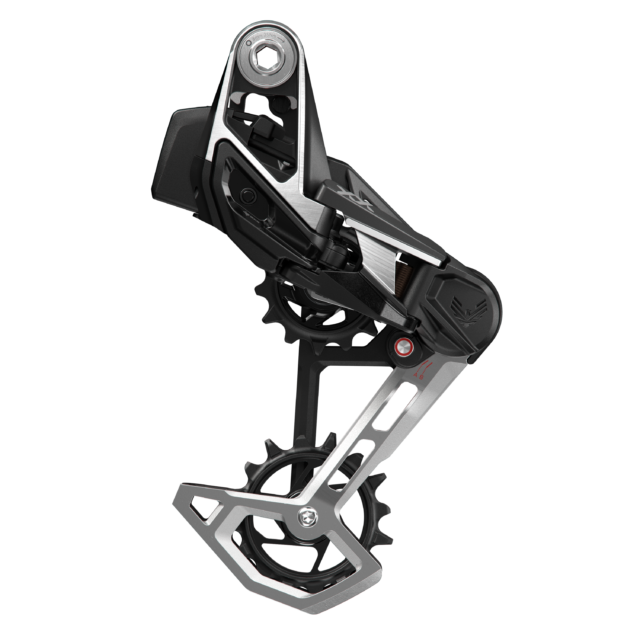
X0 Derailleur
- MSRP: $550 / €660 / £590 (Battery not included)
- Stated Weight: 475 g
- Blister’s Measured Weight: 472 g (including battery)

Controllers

To go with the new AXS derailleurs, SRAM has revised its controllers, with two subtly-different new options featuring a decidedly different design from their previous offerings.
SRAM is calling both versions a “Pod Controller” and the two new versions are mostly pretty similar to each other. The Ultimate level Pod Controller has replaceable buttons with options for concave or convex button covers (or one of each, if you’re so inclined) to dial in the tactile feel. The standard Pod forgoes the swappable buttons but its functionality is otherwise identical. Its concave buttons are visually slightly different from those used on the Ultimate version of the pod, but feel extremely similar.
Both versions of the Pods are ambidextrous, and simply get flipped in their mounts to toggle between left- and right-handed operation. As with the older-style controller, the button mapping is programmable in the AXS app so that you can control the shifting, AXS dropper post operation, and/or RockShox Flight Attendant suspension as you see fit.
The new controller pods can be mounted with your choice of a standard 22.2 mm bar clamp (which SRAM calls an “Infinity Clamp”) or an integrated “Bridge Clamp” that connects to a Matchmaker X compatible brake lever mount. The Infinity Clamp can be run on either side of the bar by flipping the clamp left to right — the mounting interface for the controller pod is the same 22.2 mm diameter as the mounting area on a standard handlebar — but the Bridge Clamps are left- and right-hand-specific. With either clamp, you can move the overall position of the controller pod both in terms of its clocking around the bar, and its position along the length of the bar, and rotate the pod itself in its clamp to change the orientation of the buttons.
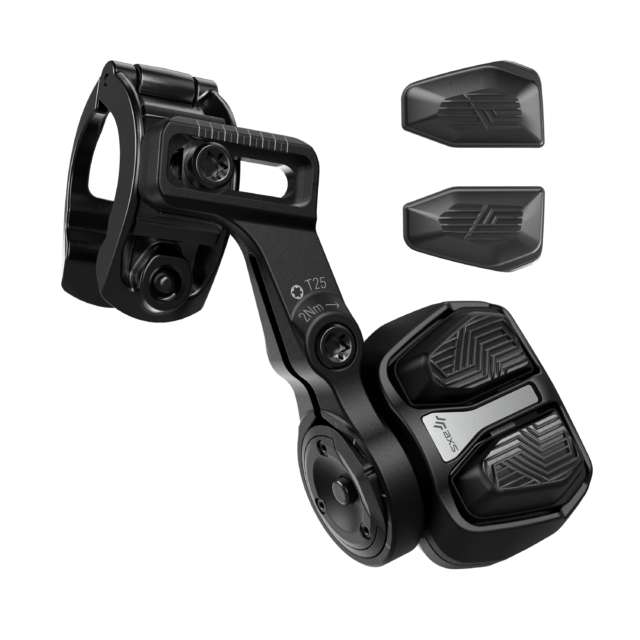
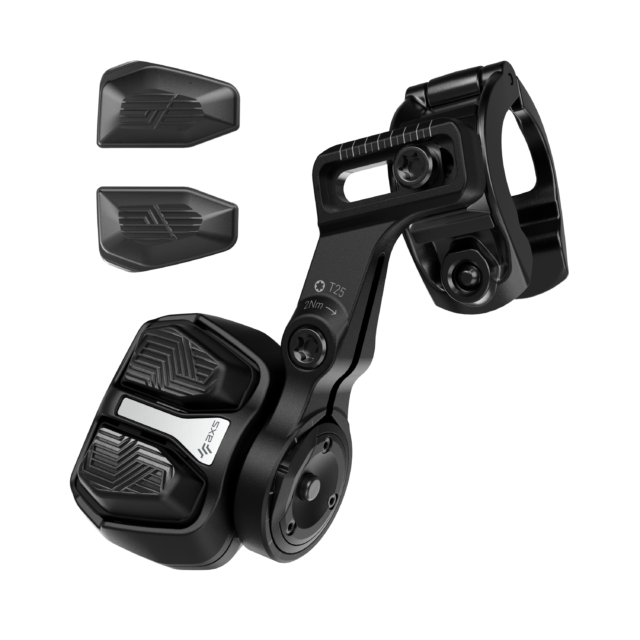
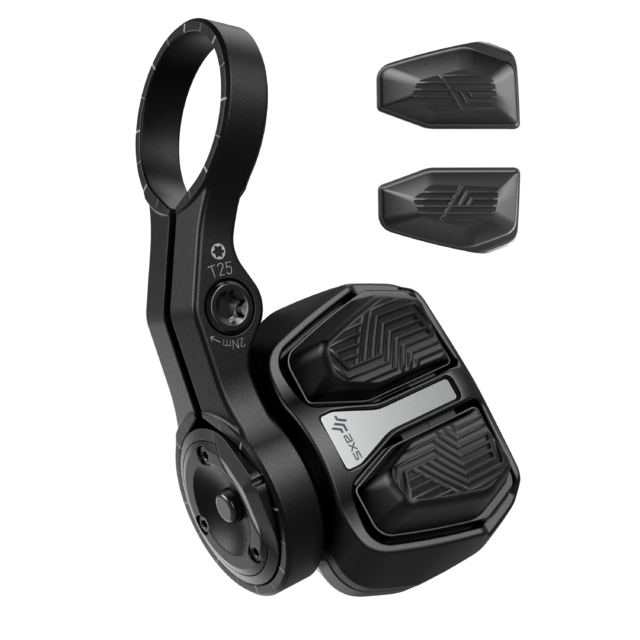
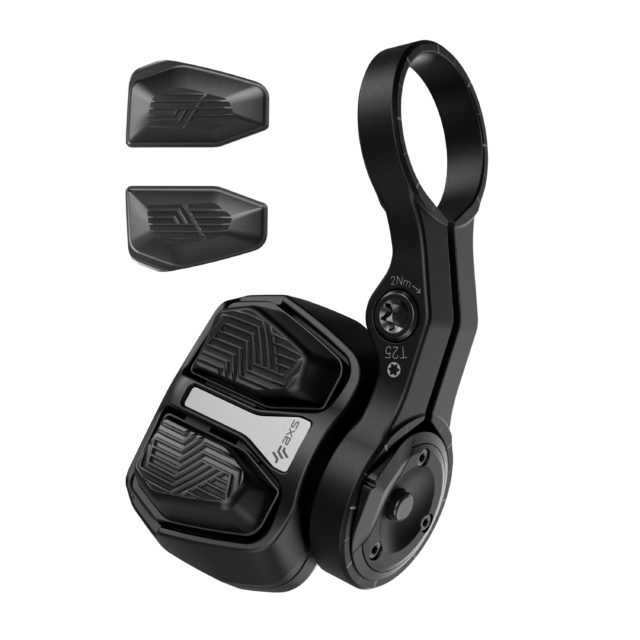
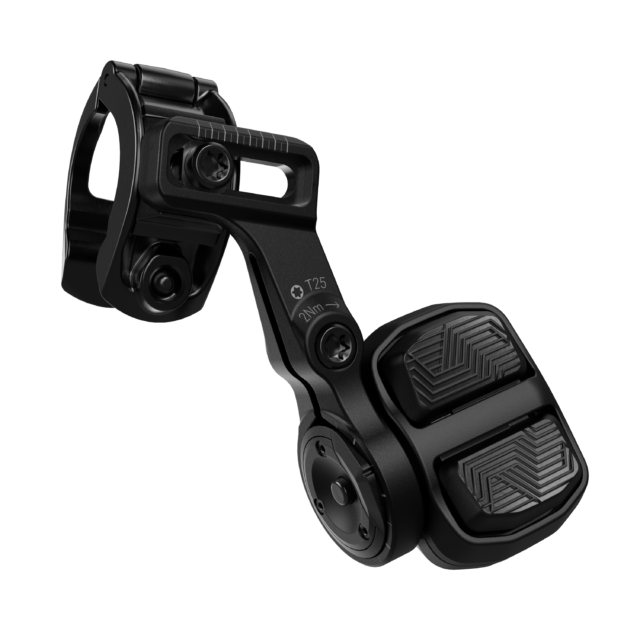
Cassettes

The new derailleurs are grabbing headlines for obvious reasons, but SRAM has given the matching cassettes a big overhaul as well, and the updates play a key role in the whole transmission package.
They’re still 12-speed with a 10-52 tooth range (there’s no 50-tooth version, at least for now) and mount to a standard XD driver on the hub (the same one that SRAM’s used for their 1x drivetrains dating back to the original XX1 11-speed) but there are big changes in the finer details.
For starters, the tooth profile has been overhauled to work with the new T-Type chains (more on those in a minute) including an X-Sync narrow-wide profile on the majority of the cogs (only the 7th gear uses an odd number of teeth and therefore can’t accommodate the narrow-wide arrangement). And to go with those new tooth profiles, the cassettes use especially strongly defined shift ramps in both directions at various points between each successive pair of cogs. That idea isn’t entirely new — SRAM and other brands have been doing conceptually similar stuff for a while now — but where it gets really interesting is in how it works in conjunction with the derailleur software.

In short, the derailleur knows what gear it’s in and which one it’s being shifted to, and on the basis of the gear shift being performed and the number of ramps between the relevant gears, it makes something of an educated guess as to how to time the motion of the derailleur to perform that shift as smoothly and precisely as possible. Since the derailleur doesn’t know how the cassette is clocked at any given moment, it is still something of a guess, but the idea is to improve shift smoothness and, especially, make for cleaner and more precise shifting under power than prior SRAM drivetrains. Frankly, Shimano’s Hyperglide+ 12-speed systems have had a clear advantage over SRAM on that front for a while now, but SRAM is talking a very big game about the new T-Type system, saying it shifts better under load than anything else out there.
SRAM has also tweaked the construction of the new cassettes a bit, using the X-Dome machined steel construction that the existing X01 and XX1 cassettes use for gears 2–12 for a slightly narrower portion of the cassette, with gears 4–12 being a single machined piece, and second and third gears being separate pieces that are pinned to the biggest cog. The lowest gear is still aluminum across the board, with the material of the second and third cogs varying by cassette version — more on those in a minute.
Along with those construction changes, the gear ratio steps have been smoothed out in the lower gears, with the lowest three going 38–44–52 instead of 36–42–52. (The full spread is 10–12–14–16–18–21–24–28–32–38–44–52, for those who are curious.) As someone who found the 42–52 jump on the older models to be too big and make for an awkward jump in cadence, I’m pleased to see things smoothed out a bit. Those jumps are still a little wider than those on Shimano’s offerings (39–45–51) All of the cassette versions also feature a red-labeled “setup cog” to streamline the installation and setup process, which we dive into in more detail below.
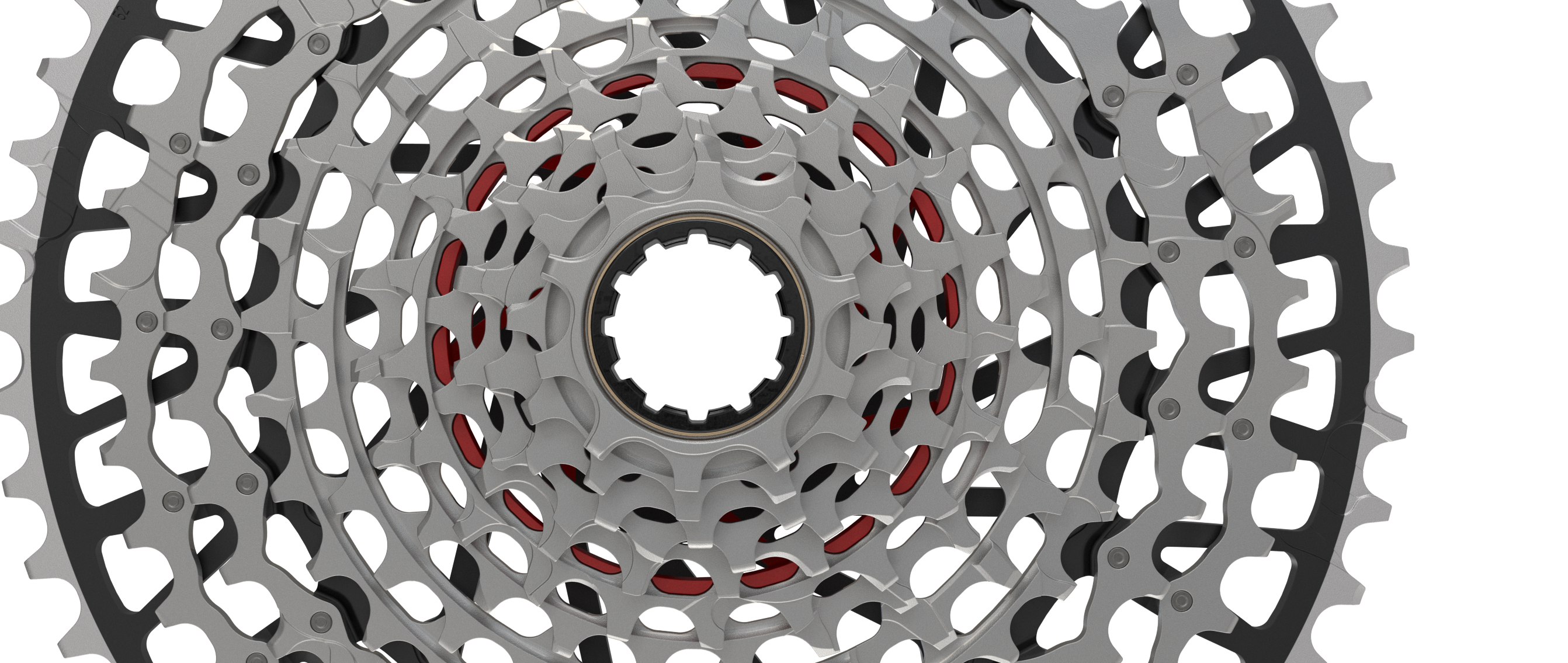
XX SL Cassette
- MSRP: $600 / €720 / £645
- Stated Weight: 345 g
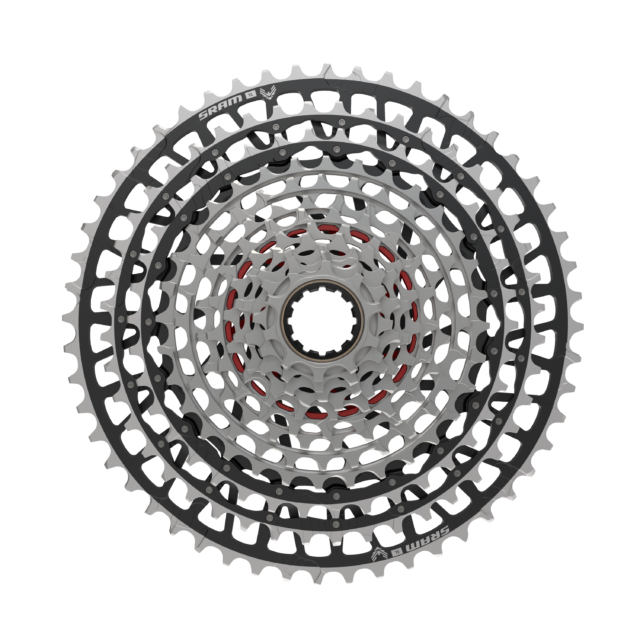
In keeping with the “SL” part of “XX SL” this version of the cassette uses aluminum for the three largest cogs, with the remaining eight being machined from a single piece of hardened steel. SRAM’s claimed weight of 345 g makes it the lightest Eagle cassette they’ve made to date — about 30 g lighter than the prior-generation XX1 version.
XX Cassette
- MSRP: $550 / €660 / £590
- Stated Weight: 380 g
- Blister’s Measured Weight: 381 g
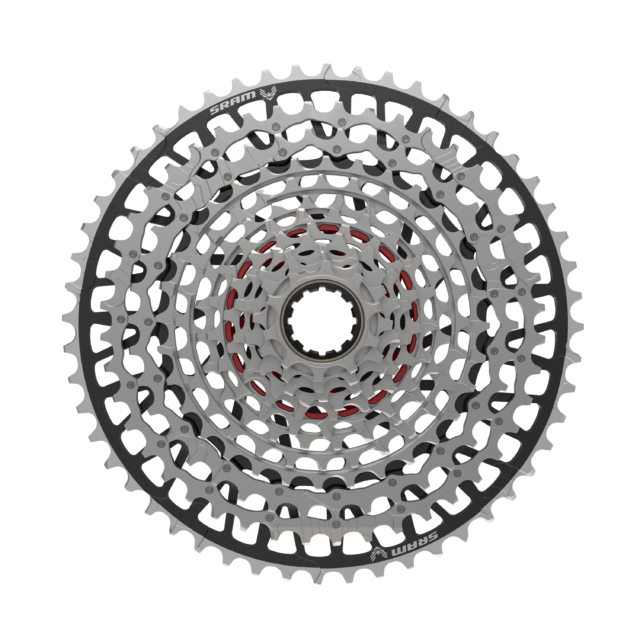
X0 Cassette
- MSRP: $400 / €480 / £430
- Stated Weight: 380 g
- Blister’s Measured Weight: 381 g
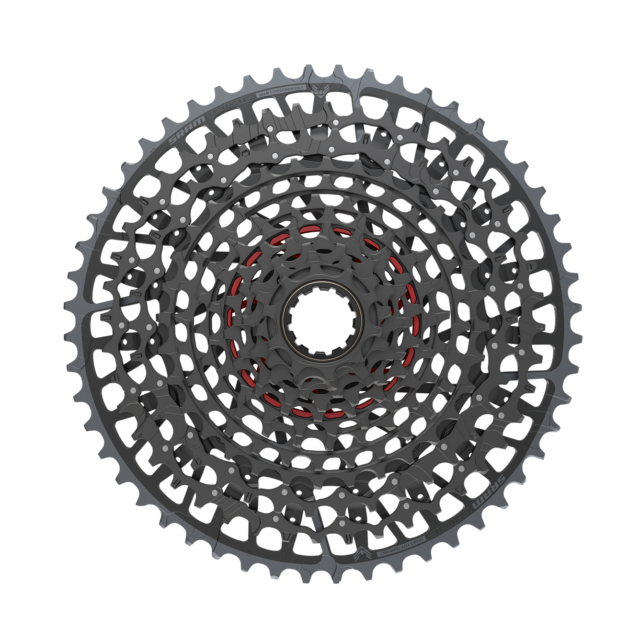
Cranks

SRAM has, unsurprisingly, rolled out a new line of cranks as part of the new transmission system, using their familiar DUB spindle and bottom brackets. While the design of the crank attachment hasn’t changed much in terms of its overall design and form factor — it still uses a spindle that’s fixed to the non-drive-side crank arm, with an adjustable preload collar and a single self-extracting fixing bolt on the drive side arm — SRAM does say that they’ve made some improvements to the thread design so that it takes less torque to remove the cranks. That’s going to be a welcome change for anyone who’s dealt with a stuck DUB crank in the past (assuming the tweaks pan out as intended).
What has changed, from a compatibility standpoint, is the chainring interface. While the new cranks still use direct-mount chainrings, SRAM has swapped them to the eight-bolt interface that they’ve been using on their road cranks for a while now, from the three-bolt design that has been used on their mountain cranks up to this point. The primary driver of that change is, apparently, to make the new cranks compatible with the new spider-based power meter offered as an option on the XX SL crank — more on that in a minute. The chainrings have, of course, been redesigned to work with the switch in mounting standard, as well as the new T-Type chain profile, as described below.
SRAM has designed the new cranks around a 55 mm chainline to match the 2.5 mm offset on the new cassettes and to streamline frame compatibility instead of offering different options for 52 and 55 mm chainlines. That does mean that 142 mm non-Boost frames don’t play nice with the new cranks, but there aren’t many of those that feature a UDH and are therefore compatible with the T-Type derailleur anyway.
The new chainrings are available in 3 mm and 0 mm offset versions for Boost and SuperBoost bikes, respectively. The T-Type chainrings are backward compatible with non-T-Type Eagle chains, but not the other way around — you need the new chainrings (and thus cranks, given the switch in mounting standard) to work with the revised T-Type chain profile.
XX SL Crankset
- MSRP (Standard version): $550 / €660 / £590 (includes chainring)
- MSRP (w/ spider-mounted power meter): $1,050 / €1,260 / £1,125 (includes chainring)
- Stated Weight: n/a
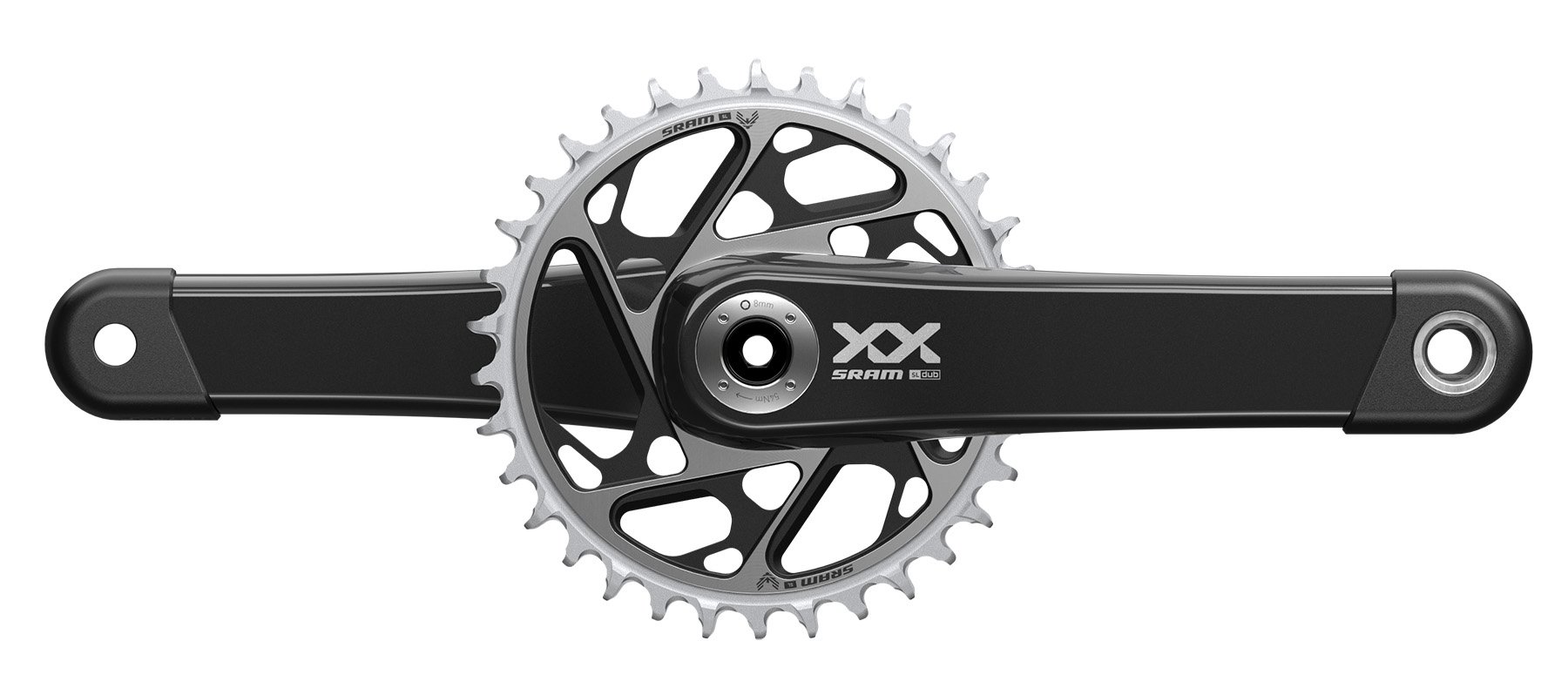
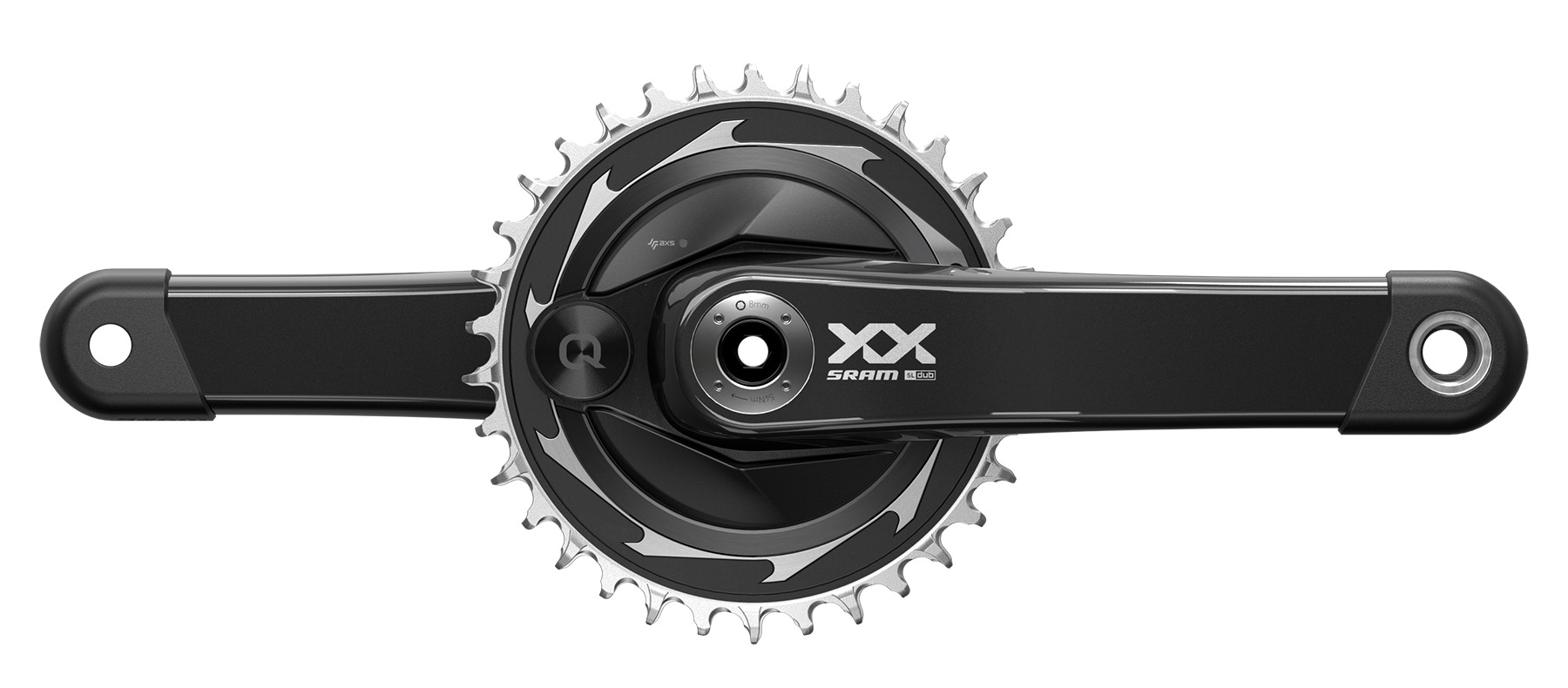
SRAM says that the XX SL crankset is the lightest mountain bike crank they’ve ever made, though they don’t yet have a published weight listed. The XX SL crank gets hollow carbon fiber construction for the arms. It’s offered in 165, 170, and 175 mm lengths with 32, 34, 36, or 38 tooth chainrings, either as a standard crank or with SRAM’s spider-mounted power meter. The standard crank uses the same eight-bolt direct mount chainring standard that’s used on the rest of the line; the power meter version uses the same arms, with the power meter unit using that eight-bolt interface and the chainring itself threading onto the power meter.
That thread mount interface requires a special extraction tool (sold separately) since pedaling torque tightens the chainring onto the power meter spider; the eight-bolt interface uses T20 Torx heads. As with the rest of the line, the XX SL crankset is designed for XC race use, and thus forgoes the bashguard option offered on the other cranks in the line, and features lighter construction, presumably with some loss of strength.
Though the XX SL crank is offered with a 55 mm chainline only (which becomes 58 mm with the optional 0 mm offset chainring) there are options for a standard and narrow Q-factor, at 174 and 168 mm, respectively.
XX Crankset
- MSRP (E-bike version): $250 / €300 / £270 (w/o chainring)
- MSRP (Standard version): $500 / €600 / £535 (includes chainring + bash guards)
- MSRP (w/ spindle-mounted power meter): $750 / €900 / £805 (includes chainring + bash guards)
- MSRP (w/ spider-mounted power meter): $950 / €1,140 / £1,020 (includes chainring)
- Stated Weight: n/a
- Blister’s Measured Weight: 600 g (170 mm crank arms and spindle, 32t chainring, 2x bash guards, crank boots, w/ spindle-mounted power meter)

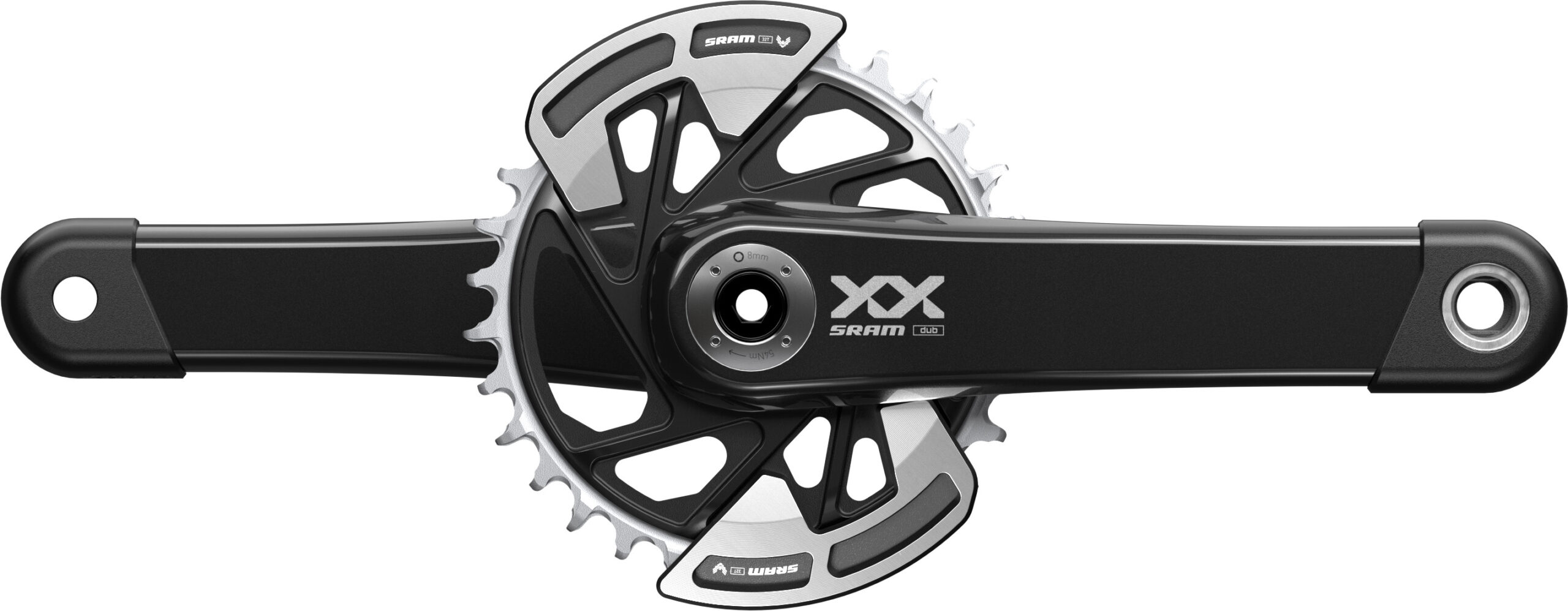
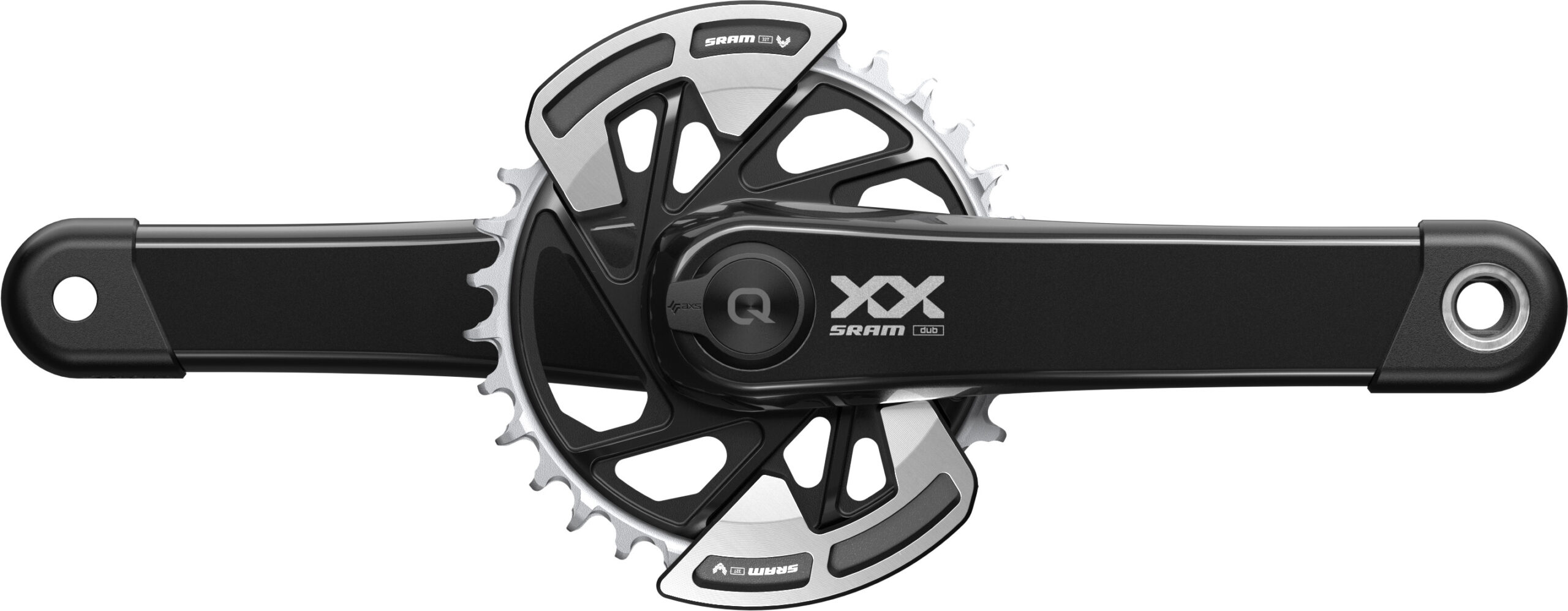
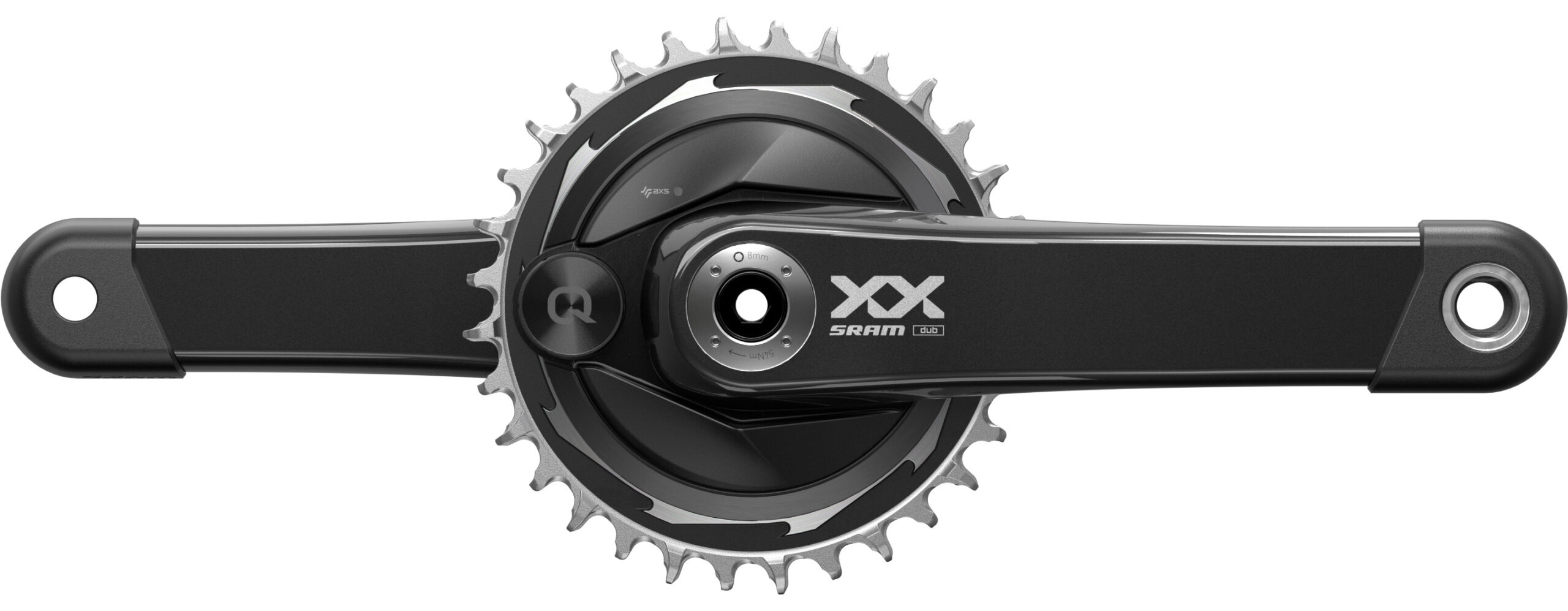
The XX crank is visually nearly identical to the XX SL one but features beefed-up carbon fiber construction with a foam core for greater strength and stiffness. It’s offered in the same 165, 170, and 175 mm lengths as the XX SL crank, but only in the wider 174 mm Q-factor and with 32, 34, or 36 tooth chainrings. The XX crank also adds a pair of removable chainring-mounted bash guards that offer partial coverage for the lower portion of the chainring when the cranks are horizontal; they bolt to the direct-mount chainrings from the inside, and you can run both, one, or neither depending on your preferences.
The XX crankset is available with options for both a spindle-mounted power meter or the spider-mounted one, as well as a standard version without either. The spindle-mounted power meter is slightly less expensive than the spider-mounted one and doesn’t require the special threaded mounting chainrings (and their dedicated removal tool), as well as offering better battery life (stated at 400+ hours vs. 200 for the spider-mounted one); the spider mounted version is claimed to be lighter (though we don’t yet have numbers for how much) and more accurate (+/- 1.5% as compared to +/- 3% for the spindle version). At least some of the weight and battery life differences are presumably down to the differences in batteries used (a AAA for the spindle version and a CR2032 for the spider one).
In addition to the option for a spindle-mounted power meter, there’s an XX e-bike crankset on offer, in the same 165, 170 and 175 mm lengths with an ISIS interface and a variety of options for T-Type e-bike chainrings in Bosh, Brose, and Steps direct-mount versions, as well as a 104 mm BCD four-bolt offering. All of the direct-mount e-bike chainrings use an aluminum carrier with steel teeth; the 104 mm ring is steel.

X0 Crankset
- MSRP (E-bike version): $150 / €180 / £160 (w/o chainring)
- MSRP (Standard version): $300 / €360 / £320 (includes chainring + bash guards)
- MSRP (w/ spindle-mounted power meter): $400 / €480 / £430 (includes chainring + bash guards)
- Stated Weight: n/a
- Blister’s Measured Weight: 750 g (170 mm crank arms and spindle, 32t chainring, 2x bash guards, including power meter + battery); 714 g w/o power meter
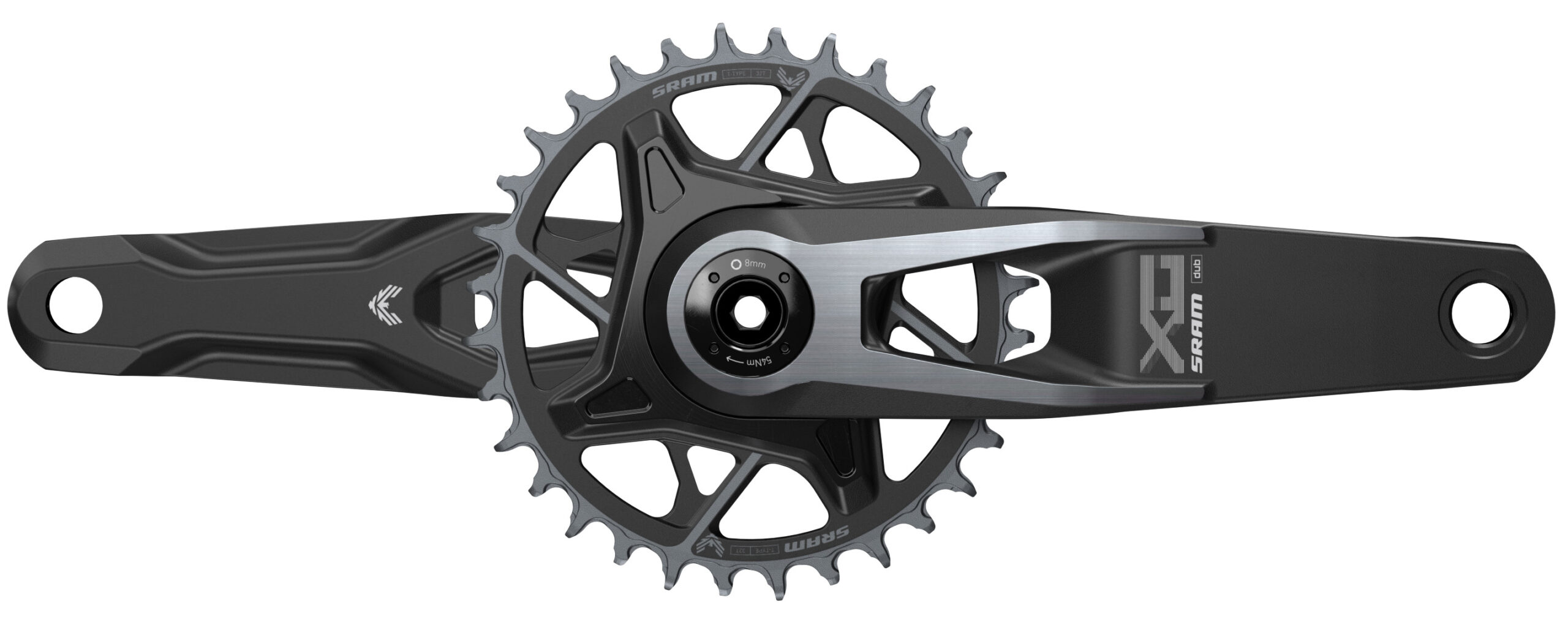
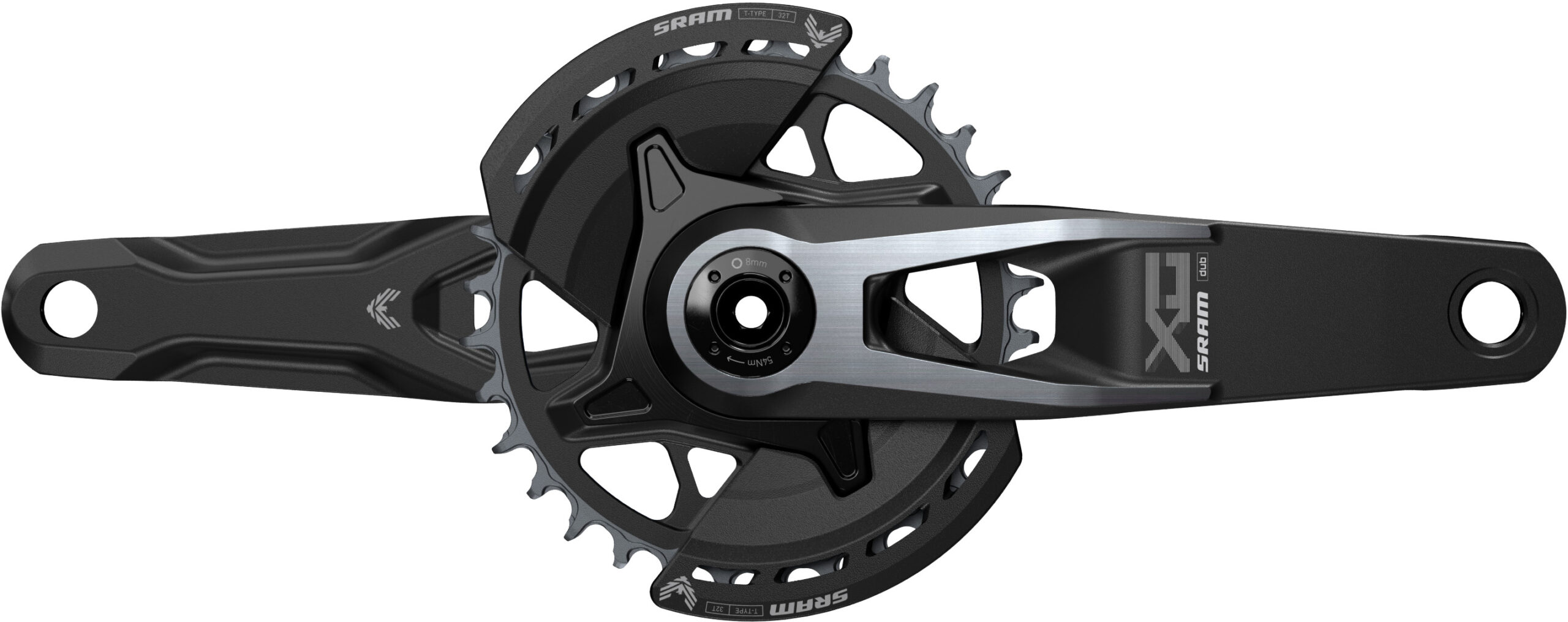
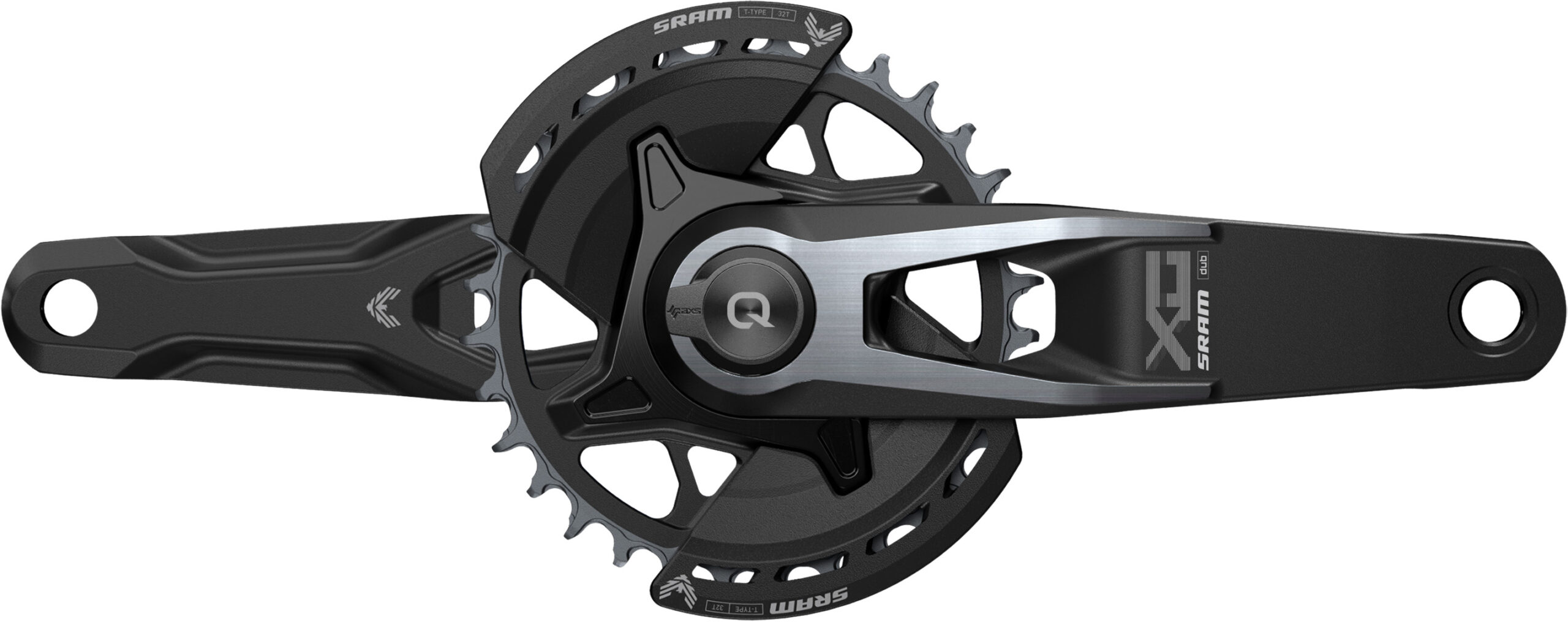
In contrast to the XX and XX SL cranks, the X0 one is made from aluminum — and in some ways, it’s the most interesting of the bunch. The shape is especially eye-catching, with a complex forging that features a big hole through the arm to move material where it’s needed for stiffness and strength while paring it away elsewhere. And then to save a little extra weight, SRAM has added a gun-drilled hole down the middle of the crank arm, starting at the outer end and running through the pedal threads and down the center of the arm.
The X0 crank is available with or without a spindle power meter but doesn’t offer the spider-based version offered on the higher-end cranks. It comes in the same 165, 170, and 175 mm lengths as its carbon fiber siblings, with a 30, 32, or 34 tooth chainring. Optional bash guards are included, as with the XX crank. There’s also an e-bike version of the X0 crank (which gets a similar aesthetic but in a simpler construction without the cutout) in 160, 165, and 170 mm lengths.

Chains

XX SL Chain
- MSRP: $150 / €180 / £160
- Stated Weight: 240 g

XX Chain
- MSRP: $125 / €150 / £135
- Stated Weight: 247 g

X0 Chain
- MSRP: $100 / €120 / £105
- Stated Weight: 256 g
- Blister’s Measured Weight: 282 g

Groupsets



If you want to buy the whole Eagle Transmission package as a groupset, SRAM is offering packages to do just that. If you want to mix and match across drivetrain levels, you’ll need to piece things together yourself. All of the groupsets include a Pod Ultimate controller, derailleur, cassette, chain, and crank and chainring (with bashguards, if applicable), plus an AXS battery and charger (which are sold separately from the derailleurs on their own). We’re not going to list every possible option for crank lengths, chainring sizes, and so on (check the SRAM website for the full rundown) but the general breakdown and pricing are below:
- X0 Groupset w/o power meter: $1,599 / €1,900 / £1,715
- XX Groupset w/o power meter: $2,049 / €2,450 / £2,195
- XX Groupset w/ spindle power meter: $2,299 / €2,750 / £2,465
- XX SL Groupset w/o power meter: $2,199 / €2,650 / £2,355
- XX SL Groupset w/ spider power meter: $2,699 / €3,250 / £2,890
The E-bike versions are offered with either a 104 mm BCD chainring but no cranks, or in Bosch and Brose versions with the E-bike crank and applicable direct-mount chainring:
- X0 E-bike Groupset w/ 104 mm BCD chainring, no cranks: $1,299 / €1,370 / £1,240
- X0 E-bike Groupset w/ crank: $1,449 / €1,550 / £1,400
- XX E-bike Groupset w/ 104 mm BCD chainring, no cranks: $1,599 / €1,700 / £1,530
- XX E-bike Groupset w/ crank: $1,849 / €2,000 / £1,715
Installation & Setup
A huge part of the story with the new Eagle Transmission is the installation and (lack of) adjustment process — SRAM has put a ton of effort into streamlining the setup and minimizing the need for subsequent adjustments. We’re not going to go through every little detail step by step (SRAM’s instruction manual covers the finer points if you want to take a deep dive) but instead hit the main ones.
Installing the cassette, bottom bracket, and crankset isn’t really any different from the longstanding Eagle groupsets and DUB crank / bottom bracket — nothing new there. The interesting part is when you get to the derailleur and chain. SRAM’s instructions break the steps down into three main sections: prepare, hang, and tighten — notice that there’s no real “adjust” or similar step here. The whole process is a bit different from what you’re probably used to, but it’s very, very slick.
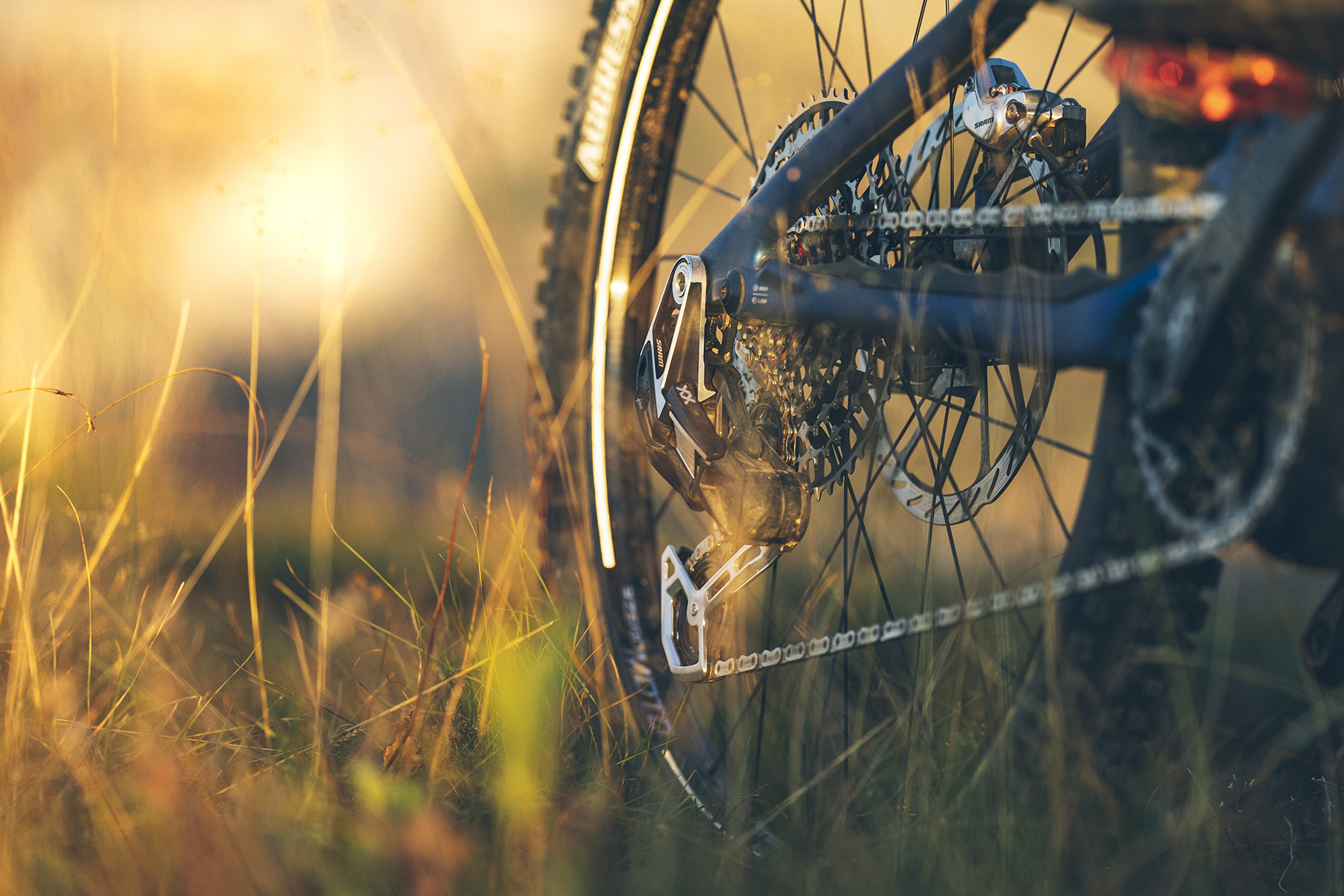
The short version is as follows:
(1) First, pair the derailleur and controller pod(s) by (1) pressing and holding the AXS button on the derailleur until the LED on the derailleur blinks slowly then (2) pressing and holding the button on the controller pod (start with the right one if you have two) until the LED on the controller blinks quickly, then repeat for the left controller, if applicable. Finally, you end the pairing by pressing the AXS button on the derailleur (or just wait 30 seconds for it to time out). And that’s it. The AXS app isn’t needed for installation or setup, though it does allow you to do some additional functions such as customizing the button layout on the controller(s) and setting some other small features (such as whether or not the transmission will perform multiple shifts if you hold the button down).
(2) Now you’re on to the actual “Prepare” step in the instructions. That begins with figuring out your required chain length. SRAM has a chain calculator database on their site with the required chain length for a whole lot of bikes, with slight variations based on chainring size. If your bike isn’t listed, there’s a separate chart that gives you a required chain length (in terms of number of links) based on the gearing you’re using and the chainstay length of the bike in question. Things get a little more complicated if you have a bike with an idler pulley, but SRAM has separate instructions for those bikes as well; consult those if applicable. In most cases, you’ll be able to just get a number of links from the calculator, count them out, cut the chain, and go. A full-length chain has 126 links, so you can count down from there rather than starting from zero and working up.
(3) The chain setup guide will also indicate a “Setup Key” position and setup cog number. In most cases they’ll be “A” and 7th gear (the one labeled on the cassette with a red ring), respectively, but for a few combinations, you’ll need to move the Cage Lock button from position A to B and / or use the 6th gear for setup instead of the 7th. If you need to toggle the Cage Lock button, the whole assembly just pops out of the derailleur knuckle with a little leverage from a flat-blade screwdriver, and you pop it back the other way around. The labels on the back of the derailleur knuckle indicate which orientation is which.
(4) Finally, you need to remove the UDH from your frame and install the bushing that comes on the derailleur mounting bolt in its place, with the hole in the frame clean and dry.
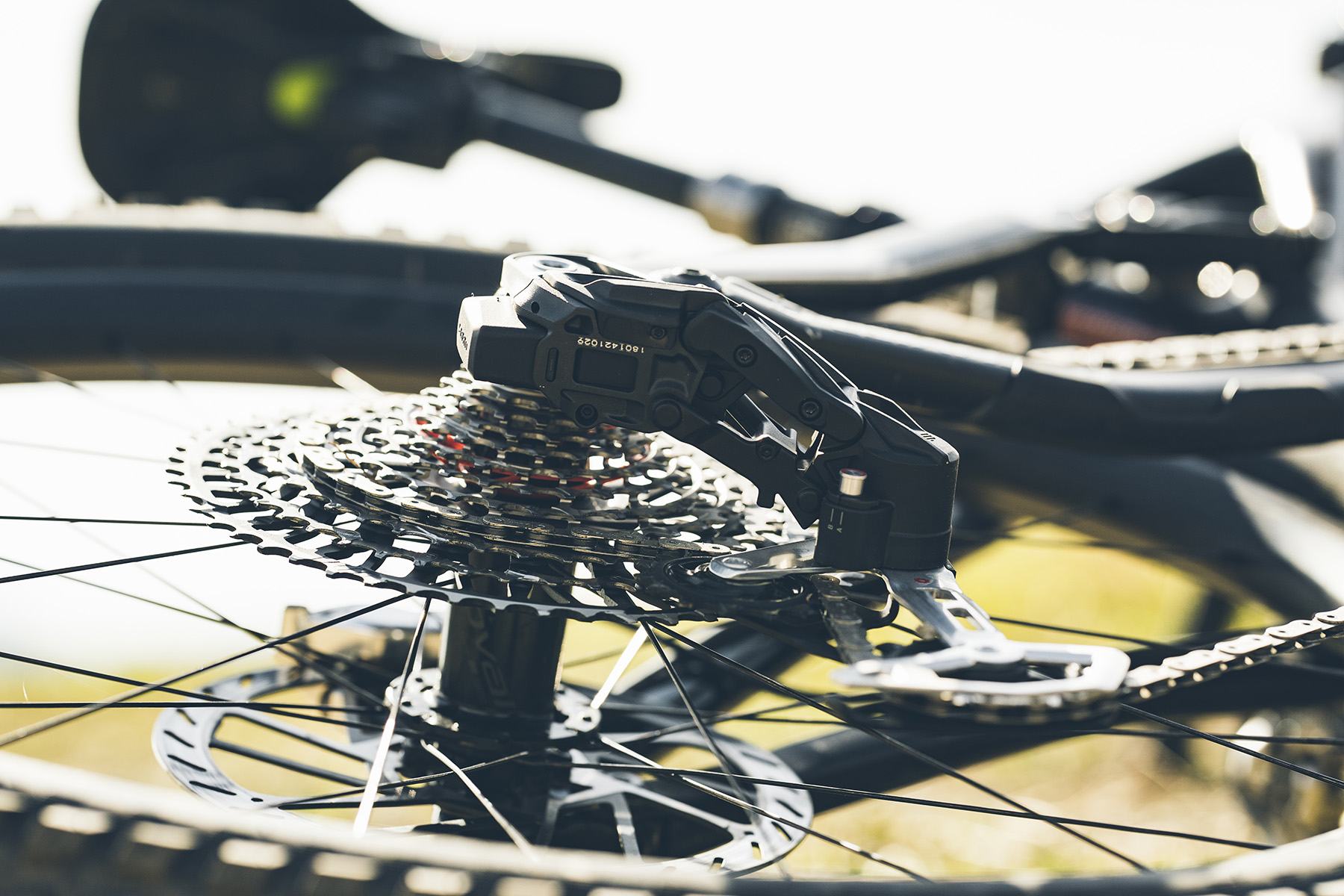
Now we’re on to the “Hang” portion of the program.
(1) In short, you slide the derailleur into place and install but don’t fully tighten the fixing bolt. Once the derailleur is hung you push the cage forward and latch it into the forward position (past the Setup position) using the Cage Lock button, then install the rear wheel and axle (also leaving them loose by one full turn).
(2) With everything in place, you’re ready to install the chain. Shift the derailleur into the setup cog (either 6th or 7th gear, as indicated in the instructions) and route the chain around the chainring and cassette and through the derailleur cage, making sure that it’s seated on all the teeth properly and in the correct orientation. Install the PowerLock link to connect the chain.
(3) Once the chain is installed, rotate the derailleur cage forward to release the Cage Lock button, then reposition the cage to lock it into the Setup position. Rotate the cranks until the PowerLock link is above the chainstay and (making sure that both halves are still properly aligned) snap it into place.
Now everything’s mounted up and you’re ready to Tighten.
(1) With the derailleur still locked into the Setup position, rotate it rearward until there’s no slack in the chain. While holding the derailleur, pedal the crank forward two rotations to make sure the chain stays in place on the setup gear, then tighten the derailleur fixing bolt to 35 Nm while holding the derailleur back to maintain chain tension. This process effectively sets the B-tension on the derailleur (instead of needing a dedicated screw like on other derailleurs).
(2) Tighten the rear axle down to secure the rear wheel, and release the derailleur cage from Setup Mode. The derailleur is held in place by the fixing bolt in the previous step, so you won’t have to re-clock it when you take the wheel out.
And that’s it. SRAM says that most people should need to make no further adjustments to the derailleur whatsoever, but if you do need to fine-tune the alignment you can tweak it by 0.2 mm increments in either direction through either the AXS app or by using the controller (hold the AXS button and press the shift button in whichever direction you want to tweak things).
Compatibility
We’ve touched on most of this already, but to summarize the cross-compatibility of the Eagle Transmissions, the short version is that the T-Type parts are meant to be used as a complete ecosystem, and aren’t cross-compatible with other non-T-Type drivetrain parts. The small exceptions are that all versions of AXS controllers are compatible with both T-Type and first-generation AXS derailleurs (so you can use the new Pod Controller with a non-T-Type AXS derailleur, or an older controller with a T-Type derailleur) and that non-T-Type Eagle chains do work on T-Type chainrings, but not the other way around.
The T-Type derailleurs are also compatible with AXS road shifters, and the T-Type chains do work on 1x AXS road chainrings, if you want to run a hybrid setup for a wider range on your road or gravel bike (with a UDH-compatible frame, of course). eTap AXS Blips also work with the T-Type derailleurs. And to reiterate, you can mix and match the various levels of T-Type parts to your heart’s content.
Since the Eagle Transmission is only compatible with frames that use a UDH, and to maintain support for folks with older Eagle drivetrains, SRAM isn’t dropping any of the older models from their lineup, at least for now. We’d imagine that some lower-tier Transmissions are coming down the line at some point as well, and it’ll be interesting to see if that includes mechanical versions or if SRAM is betting on electronic shifting being the future for everyone.
Brakes

If the new T-Type groupsets weren’t enough, SRAM has also overhauled their brake lineup, with the biggest change being the addition of new “Stealth” levers that position the master cylinder reservoir and brake hoses much closer to the handlebar for cleaner-looking routing. And it’s not just meant for bikes with the cables routed through the headset — SRAM says that the new routing makes for shorter hoses that bounce and rattle less too. To help keep things organized, SRAM offers plastic hose clips that attach to the lower faceplate mounting bolts on stems with a wide enough gap between the stem and the faceplate, though they’re not required to use the new brakes.
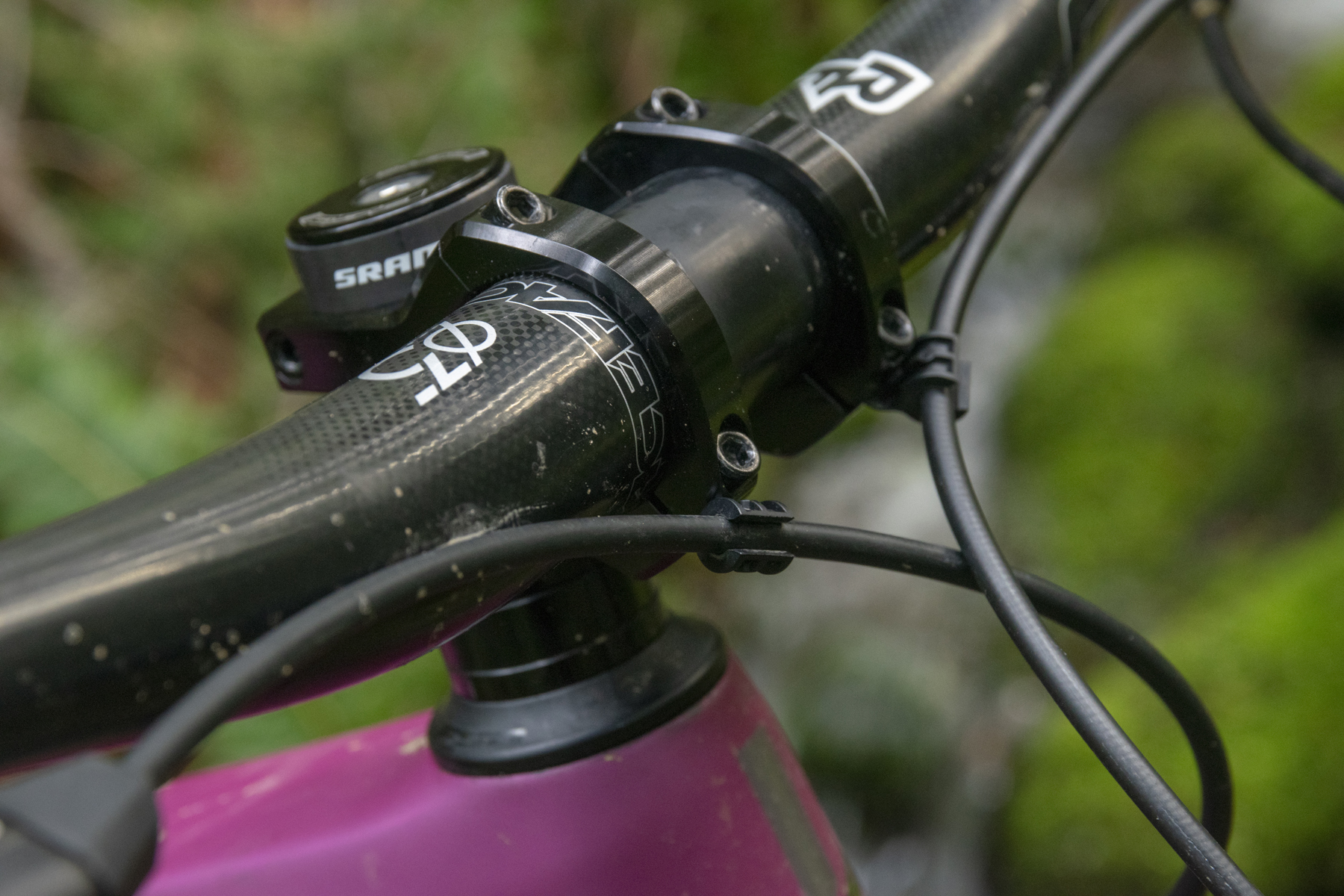
SRAM is offering the new “Stealth” brakes in two model lines — Code and Level — with six total versions of the brakes to start off.
Code Brakes
SRAM is continuing to use the Code name for their biggest, most powerful brakes in the line, and, in fact, the Code calipers carry over unchanged (apart from finish and hardware — more on that in a minute). They still use DOT fluid, the pad shape is the same, the (excellent) Bleeding Edge bleed fitting is the same, and so on. The changes are at the lever end, with the repositioned lever body being the most notable one. The new Stealth lever still uses the MatchMaker X clamps that the older versions did as well.
Internally, things are actually mostly unchanged, and SRAM says that the feel and performance of the new Code brakes are the same as the longstanding versions many folks will be familiar with. The lever shape and leverage (both mechanical and hydraulic) are unchanged; the updates are really all about the updated aesthetics and tidying up the hose routing. But with those changes, SRAM has made some tweaks to their model line and naming convention:
Code Ultimate Stealth Brakes
- MSRP: $300 / €360 / £320 per brake
- Stated Weight: n/a
- Blister’s Measured Weight: 304 g
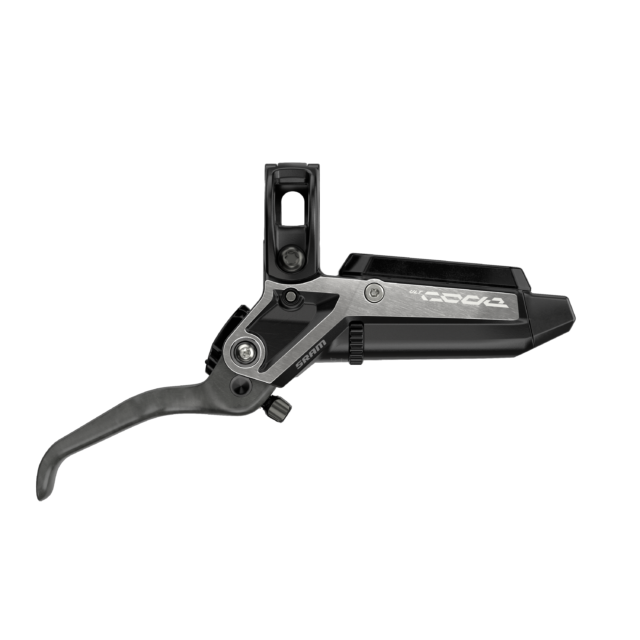
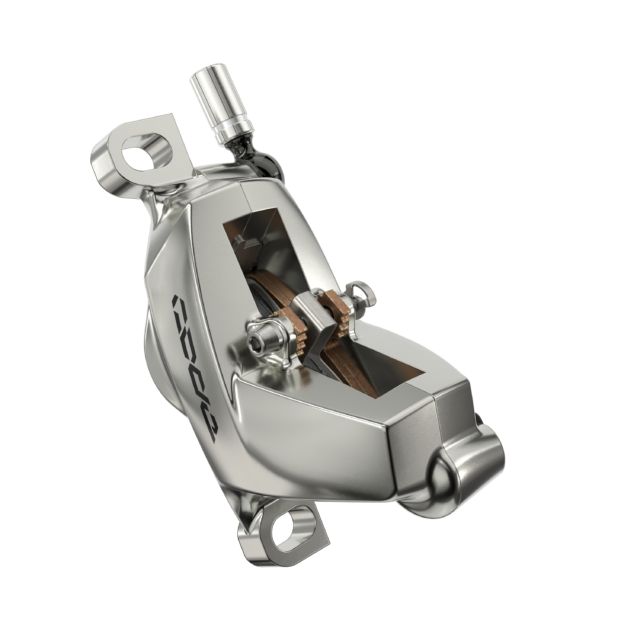
Code Silver Stealth Brakes
- MSRP: $265 / €320 / £285 per brake
- Stated Weight: n/a
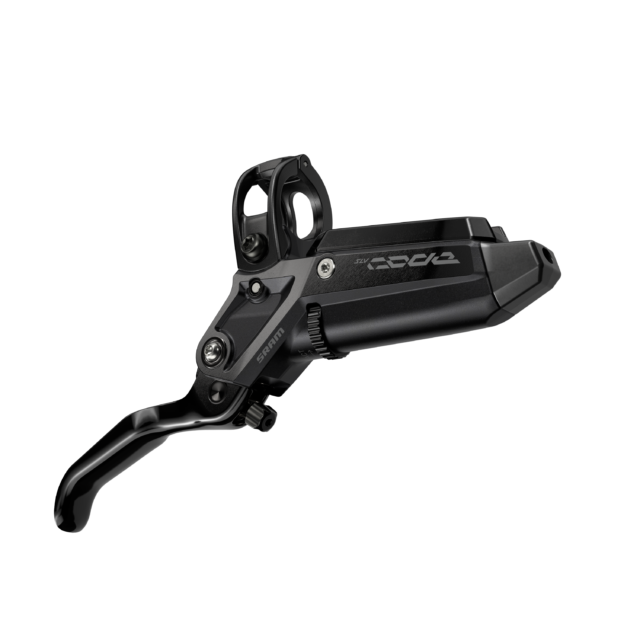

Level Brakes
Things get changed up a little more with the Level line of brakes — because there’s now a four-piston version meant for Trail bike use to go with the XC-oriented two-piston versions. Both get a new lever assembly that looks a whole lot like the new Code one, with the reservoir and hose tucked in against the bar, just in a pared-down, lighter version (which forgoes the pad contact adjuster found on the Code lever).
The four-piston version uses G2 pads (and appears to in fact be a G2 caliper mated to the new lever); the two-piston version uses the same caliper as the current-model Level. Both the two- and four-piston versions use the same lever assembly (just with different finishes), with the differences happening at the caliper end, and both get the same Ultimate and Silver tiers as the Code, again with the Ultimate versions coming with carbon fiber lever blades and stainless steel hardware, while the Silver ones sub in aluminum and stainless steel, respectively.
Level Ultimate Stealth 4-Piston Brakes
- MSRP: $300 / €360 / £320 per brake
- Stated Weight: n/a
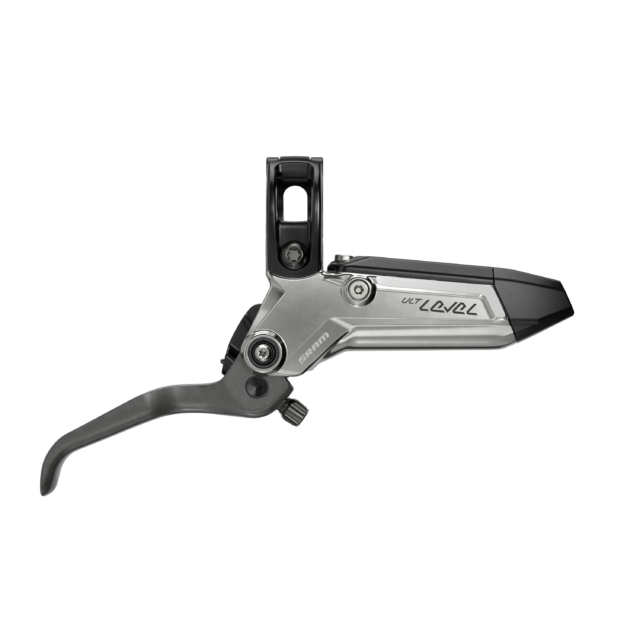
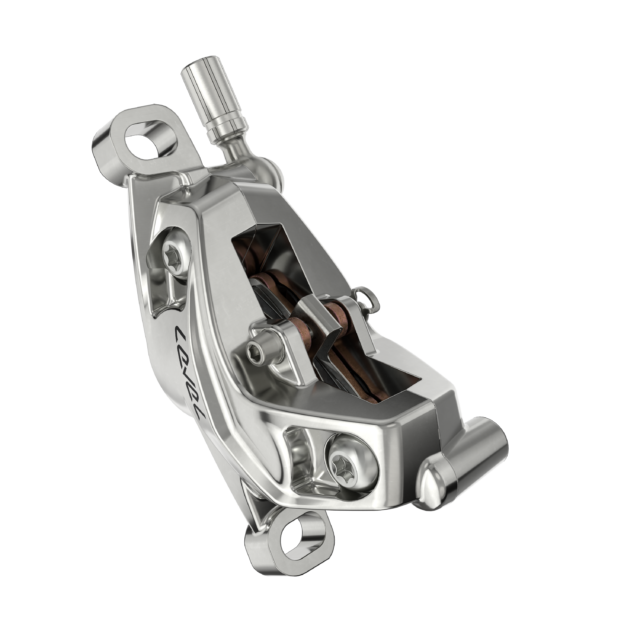
Level Silver Stealth 4-Piston Brakes
- MSRP: $195 / €235 / £210 per brake
- Stated Weight: n/a

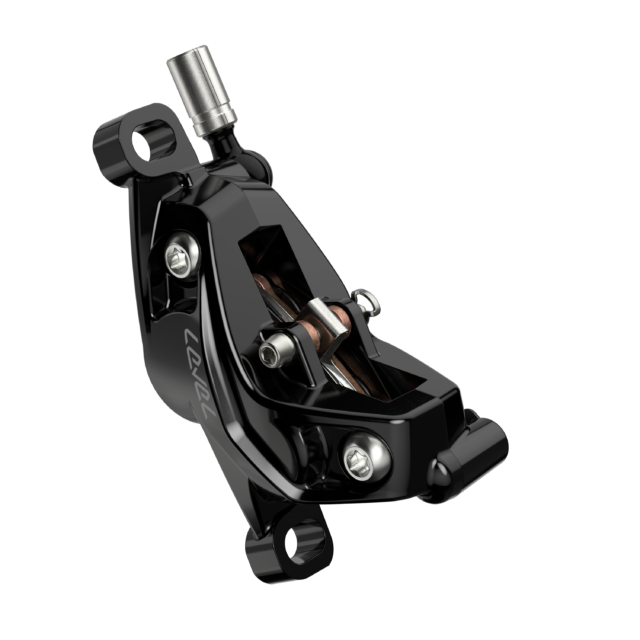
Level Ultimate Stealth 2-Piston Brakes
- MSRP: $285 / €340 / £305 per brake
- Stated Weight: n/a

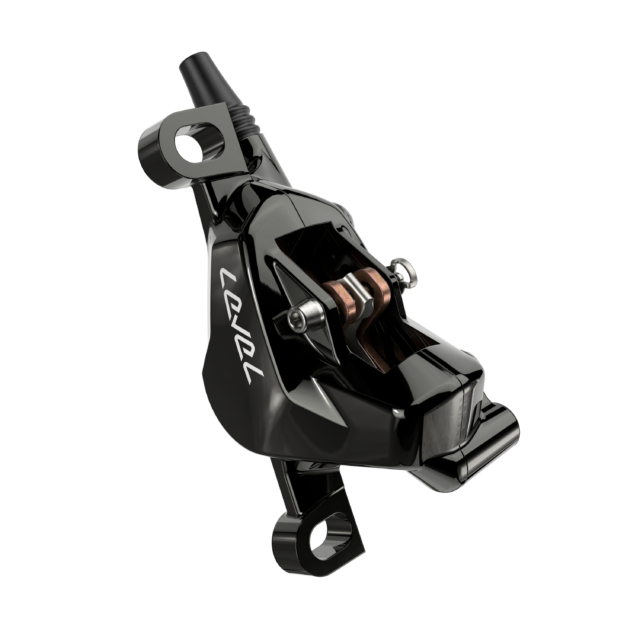
Level Silver Stealth 2-Piston Brakes
- MSRP: $185 / €220 / £200 per brake
- Stated Weight: n/a


Some Questions / Things We’re Curious About
(1) First and foremost, how does the new Eagle Transmission perform on the trail?
(2) And is the setup and installation really as easy as SRAM says it is? Will the system need much adjusting down the line?
(3) What about long-term durability? We’ve had very good luck with the first-generation AXS systems on that front (though their derailleur dampers do tend to lose effectiveness over time). How does the new T-Type system hold up — both in terms of things like impact damage to the derailleur, but also just general wear of the chain, cassette, and chainring?
Flash Review
Blister Members can read our Flash Review of the new X0 Eagle Transmission and Code Ultimate Stealth Brakes for our initial on-trail impressions. Become a Blister Member now to check out this and all of our Flash Reviews, plus get exclusive deals and discounts on gear, and personalized gear recommendations from us.
Bottom Line (For Now)
SRAM’s new Eagle Transmission is a big change to their mountain bike lineup and we’re very excited to spend a lot more time on it — in multiple versions — in the months to come to see how it performs (and holds up) on the trail. Stay tuned for much, much more to come — including an episode of Bikes & Big Ideas with SRAM’s Chris Mandell running through the whole system this Thursday, March 23rd.

Thats a big writeup! Nice work david.
Haha, out of the gates you used longstanding for the eagle platform. Laughable. This is not a transmission. It’s not self contained. It’s not contained AT ALL. It’s a profit margin. It’s propaganda. It’s trash. Pinion is a transmission. A “proper” gearbox, if you will. After riding rear mounted, exposed, bended, breakable trash for my whole life I will never be so gullible as to think sram/Shimano/campy/box has my best intentions in mind. Do better. Build better. It’s 2023(right?!, I’m drunk), we put people in space. We strategically attack oil bearing nations! We have the technology! The time is now! Bring lightweight, wide range, bottom bracket mounted gearboxes to the people!!!
Sram’s target market seems to be dentists, while Shimano’s seems to be anyone who wants a bike that works. Lemme guess, the new aluminum X0 crank that’s not compatible with anything but Sram’s extra special new dentist groupset costs around as much as the old carbon ones too, right?
Getting rid of limit screws is an answer to a problem I don’t have. They’re pretty much set and forget. Same with the B screw adjustment which doesn’t require a plastic spacer with Shimano’s derailleurs.
I have a carbon X0 crank on one of my bikes now, and it’s nice, but the rest of the drivetrain is all XT. And my other mountain bike is XT 11 speed shifter and derailleur. It’s great. I see no reason to upgrade, let alone upgrade to something that needs batteries.
Haha, I’m all for what Joseph says! Bring us lightweight wide range, bottom bracket mounted gearboxes!!
With the specific frame-needs of this here from SRAM, we’re better off leap-frogging all at once!